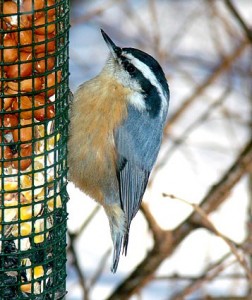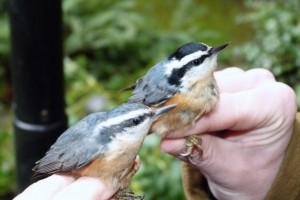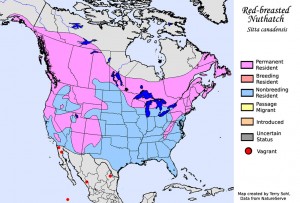What does A Red Breasted Nuthatch look like?
The Red Breasted Nuthatch (Sitta Canadensis) is physically a pudgy bird with a very small neck and a stubby body from the Nuthatch family. It has a long, sharp, and slightly upward pointed beak that it uses for foraging. Its back and upper tail are a light dark shade of blue. The wings are small and very broad with a wingspan measuring 8.5 in. Its crown and eye-line are black stripes and its eyebrow section and throat are white. In males, the bird has an orange, rusty color on its stomach while in females, the stomach is a pale color and the heads are dull colors. The males are bolder and brighter in color compare to the females as shown in photo #2.
Photo 1; Nuthatch on feeder (Zerr). Photo 2; Male and Female Red Breasted Nuthatch (Josund, 2012).
How does a Red-breasted Nuthatch behave?
The Red breasted Nuthatch has rapid movements when searching for food in the crevices of trunks and branches. They have the ability to move in all directions because of their powerful legs. There legs can support their full body weight so they do not have to use their tail for balance like other birds do. For example, a woodpecker uses its tail and two legs to balance itself in a tripod stance and other birds use their tails to stand vertically on trees. When the Red breasted Nuthatch uses its wings, it does not last long because of its build and looks as if it is bobbing up and down. When the bird moves, it looks like it is hoping around most of the time. The Nuthatch flies in short bursts to quickly get food and move around.
The Red-breasted Nuthatch is an irruptive species which means that it is a short distance migrant. The northern populations migrate to the south each year, but other populations from southern regions may not migrate at all. Those that do migrate may travel as far south as the Gulf Coast which can happen on a 2 year cycle. They generally migrate south early in July, which is earlier than other irruptive birds, and will reach their southernmost destination by October.
When a Red-breasted Nuthatch builds its nest, it becomes extremely aggressive and will chase away other hole nesting birds like the House Wren or White-breasted Nuthatch. When they get aggressive, they tend to approach certain types of birds such as Warblers or Flycatchers. They may also steal nesting material from other Nuthatches or Chickadees nest. Red breasted Nuthatches are able to displace larger birds from a feeder because of how aggressive they can be. When the male Nuthatch becomes agitated, the bird may call at another bird with their heads pointing up and fluttering their wings.
When the male bird is looking for a female during mating season, it will begin to excavate a nest in trees but will leave them incomplete. A female nuthatch does not need a male to begin building a nest so the female can start when she see fit. It could take up to 3 weeks for the bird to excavate a hole in a tree that is about 8 inches deep for their nest. The female usually would pick the location of the nest which is usually an old dead tree that would be easier to excavate or a live tree that has a dead area. After digging the hole, the female bird would then build a bed of grass, pine needles, and strips of bark and lines it together with fur, feathers and fine grass. The males feed the female while the female excavates and builds the nest. This nest is glued together with resin from conifer trees that both the male and female nuthatch are able to apply (Ghalambor, Thomas, 1999). The resin is thought to deter predators from approaching the nest.
How do they pick their mates?
Red-breasted Nuthatches are socially monogamous and display signs of pair bonding. These pairs usually begin on the breeding grounds where they build a nest together and raise their young. This bond is formed after the male does a courtship display which involves flying around, feeding the female, singing, and standing erect. (Ghalambor, Thomas, 1999)
When the pair forms during the winter, they stay as a pair during the breeding season and may maintain the relationship if there is an adequate source of food nearby. Residential pairs may stay together for less than a year and other pairs may have seasonal bonds that end when the season changes.
The female Red-breasted Nuthatch usually lays an average of six eggs that are white, cream, or pink-white. The male regularly feeds the female as she incubates the eggs that hatch after after 12 days.
When raising their young, the birds stay together and provide the young often with insects for about three weeks. After this period, the pair will withhold food from their young to encourage them to come out of the nest and remain with the adults for another two weeks. They young birds are now full fledged adult birds that join other flocks.
Where do they live and what do they eat?
Red breasted Nuthatches are found in coniferous forests on trees in places such as spruce, pine, larch, hemlock and fir. During irruptive winters, they may use trees such as orchards, scrubs, parks and plantations as their habitat.
Photo 3; Location of Red-breasted Nuthatch (Sohl, 2003)
The Red breasted Nuthatch’s diet changes depending on the time of year. In the summer, the Nuthatch is known to eat mainly insects, beetles, caterpillars, ants, earwigs, and spiders. In the fall and winter, the Nuthatches diet consists of conifer seeds and seeds that they stored earlier in the year. They also eat from feeders, taking mostly the sunflower seeds, peanut butter and suet. The Nuthatch prefers the largest food it can find that would provide the most for it. It utilizes the tree for nut and seed cracking by sticking the food in the bark and hammering them open with their beaks.
Red-breasted Nuthatches may join foraging flocks of chickadees. Nuthatches sometimes store nuts and seeds in bark crevices, covering them with pieces of bark or pebbles in order to help them get through the winter.
Authors: Elaina Peterkin and Christian Perez
References
Ghalambor, Cameron K. and Thomas E. Martin. “Red-breasted Nuthatch (Sitta canadensis)”. The Birds of North America Online. Web.1999.
Josund, K. “Winter Color Banding – Saunders Site”. Pudget Sound Bird Observatory. 2012. Web.
Sohl, T. “Red-breasted Nuthatch Range Map”. South Dakota Birds and Birding. 2003. Web.
Zerr, M. “Red Breasted Nuthatch”. All About Birds. 2006. Web.



